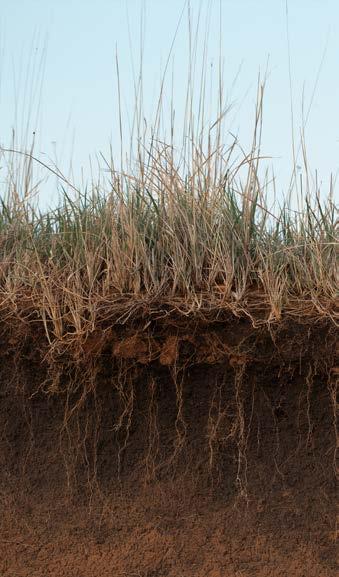

CARBON IN SOILS
An Overview of Carbon Sequestration in Grasslands


CARBON IN SOILS
An Overview of Carbon Sequestration in Grasslands
Ryan Yaden, Jennifer Chorosevic
Peer Reviewer: Heather Venhaus
How does grassland contribute to carbon sequestration, and how does it intersect with the work of Lake|Flato?
ABSTRACT
This project seeks to present an overview of the mechanics of carbon sequestration in grasslands, primarly the Great Plains of North America. We will document the current state of grassland carbon sequestration as well as options for improving it, primarily the possibility for regenerative ranching. The overview will include economic incentives for improving soil carbon intake and feature a local entity that specializes in providing carbon credits for landowners.
KEYWORDS
Carbon sequestration, Grasslands, Regenerative Ranching, Carbon credits, Soil Organic Matter
Figure 1
Dixon Water Foundation Josey Pavilion, designed by Lake Flato Architects Note. Photograph by Casey Dunn, 2014
INTRODUCTION
At Lake|Flato we have sought to better understand the impacts of design on global climate change. In addition to a focus on operational energy use, we have adopted and developed tools to test how resource extraction, manufacturing, transportation, and installation add to greenhouse gas emissions during construction, collectively known as embodied carbon. Our research has led to an emphasis on mass-timber structures that have the potential to reduce emissions compared to more commonly used concrete and steel, particularly if best practices for forestry and end-of-life design are followed. Further, masstimber has the potential to encourage carbon sequestration immediately, as we are arguably in a current crisis to avert further greenhouse gas emissions. Following our focus on reducing embodied carbon in design and construction, we have developed a greater appreciation for various carbon offsetting strategies associated with forestry practices as our firm buys carbon offsets for our business travel, typically in the form of protecting forests in areas that might otherwise be threatened with deforestation.
For us in Texas, however, the dominant form of land-use is ranching and many of our clients own ranches. We asked the question whether more might be done to reduce carbon through land-use practices, particularly if we could have some impact through our involvement with local owners and our carbon offset purchases. It turns out there is a robust collection of advocates and science-based data related to soil carbon capture and the interplay between organisms, earth, economics, and land-use. In addition, we interviewed Lew Moorman and Frates Seeligson of Soilworks, based in San Antonio, a business focused on regenerative agriculture. They provided insights into the economics of carbon offsets and ranching.
This paper seeks to clarify the following, through the lens of our architectural practice and how we might adjust our methods and practices:
• The role soil plays in the greenhouse gas cycle.
• Understand land-use in the Texas-Great Plains region.
• The effects of agricultural practice on carbon.
• How the economics of offset credits work.
The Carbon Cycle
The natural carbon cycle, known as the “fast carbon cycle” to differentiate it from the much slower geological carbon cycle is the natural give and take of carbon dioxide and equivalent gases between the atmosphere and the planet. Both land and water play crucial roles in creating the balance of greenhouse gases that have created the climate conditions for our current biological and human existence. On the land side, trees are widely known for absorbing carbon dioxide and emitting oxygen, but less well-known is the role that soil, in particular the living and decaying biological matter play. While the 2011 diagram to the right is still generally accurate as a system, the amount of carbon equivalent gases added to the atmosphere has grown to 37+ gigatons as of 2024, according to the Global Carbon Atlas.
Essentially soil is “living,” with a combination of plants that grow and microbes that decompose the dead organic matter. The plants photosynthesize and sequester carbon which is stored as Soil Organic Matter, a complex mixture of decomposing plant and animal tissue, microbes, and minerals. In a natural state there is a balance between growth and decay; even some of the additional human carbon impact [about three gigatons as of 2011] can be absorbed by natural terrestrial systems.


*all numbers in Gigatons of CO2 per year (GtC/y) based on 2011 estimates...
( xxx ) = stored CO2 CO2 Emissions CO2 absorption







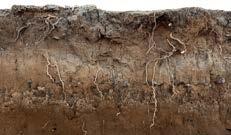


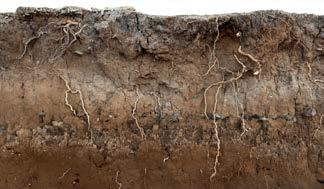




Diagram
Note. Graphic by Jennifer Chorosevic, 2022, Lake Flato Architects.
Scale of Carbon Sequestration Strategies
In order to reduce the greenhouse gases already in the atmosphere and offset the additional net of 4+ billion tons [gigatons] that humans add annually that cannot be absorbed by the natural carbon cycle, there are a number of strategies being explored with various efficacy and costs. The paper “Negative Emissions: Costs, Potentials and Side Effects” by Fuss et al, looked at potential outcomes for six prominent greenhouse gas reducing approaches. Not surprisingly the ranges for these experimental strategies were quite large depending on the source material and assumptions, but overall the prudent approach would be to continue to explore each of them in the hopes of reducing the human-made greenhouse gas burden.
Soil sequestration rated quite favorably next to the more well known and understood tree planting [Aforestation] with a potential to reduce greenhouse gases by 2.3-5.5 gigatons of carbon dioxide equivalent [CO2e] per year. Both strategies, however, are subject to a similar challenge: how to allocate increasingly limited land with a growing population that desires the resources that land can give, whether it be housing, food or minerals. The Salk Institute’s Harvesting Plants Initiative is one example of research being done into how roots and soil can play a role in reducing our atmospheric carbon. At the heart of considering soil sequestration is a conversation about land use, which is a complex and fraught conversation that involves private and public property, laws and incentives, and even the food we put on our tables.

Figure 3
Ishawooa Mesa Ranch, designed by Lake Flato Architects Note. Photograph by Joe Fletcher, 2018.
Scale of carbon sequestration strategies

Note. Graphic by Ryan Yaden, 2022, Lake Flato Architects.


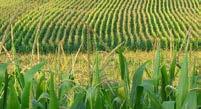

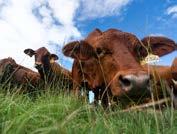
SOURCE:
Major Land Uses of the United States, 2012
Daniel P. Bigelow and Allison Borchers
USDA Economic Research Service Economic Information Bulletin Number 178, August 2017

1,900 million
acres in Continental US*
*”continental” excludes Alaska and Hawaii. If these states were included, the total acreage of US land is closer to 2,300 MILLION acres, with significant increases in forested land, special-use areas, and miscellaneous land.
Note. Graphic by Jennifer Chorosevic, 2022, Lake Flato Architects.
Land Use Patterns and Trends
The USDA maintains a database of land use in the United States. We looked at their data for the continental U.S, excluding Alaska and Hawaii for this study. The following data are from 2012, revised in 2017.
• 1.9 billion acres of land in the continental United States.
• 69 million acres are designated as Urban, or about 3.6% of the continental total.
• 69 million acres is Miscellaneous, made up of wetlands, tundra, and unproductive woodlands.
• 169 million acres is Special Use, 8.9% of the total. These are wildlife and national/state parks. This is about 3 million acres in Texas.
• 539 million acres is Forested, 28.4% of the total. About 10 million acres are harvested and replanted each year.
• 654 million acres is designated Grazing, or ranchland, 34.4% of the total. The largest single use category, likely less than 3% is regeneratively ranched. In Texas grazing makes up 62% of our land use.
• 392 million acres is Rowcrops, 20.6% of the total. Of this about 40 million acres is used for biofuels and 90 million acres for corn, the fastest growing share over the decades.
The intersection of ranchland and rowcropping is understandable and important. Animals depend on feed which can be provided for by open rangeland, but the industry has mostly evolved to utilize corn which has been subsidized to cheaply create feedlots. In fact, of the 90 million acres of corn grown in the continental U.S. about 40% is used for livestock feed and another 45% is used for biofuels. There has been a striking uptick in rowcropping over grasslands in recent decades.
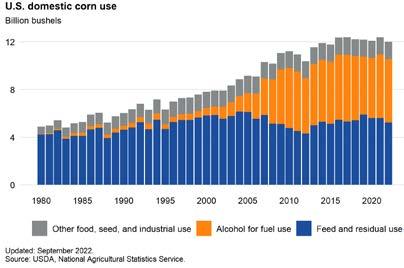
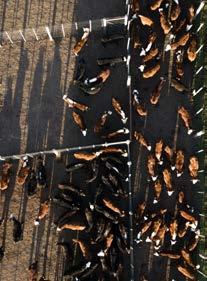
Feed lots
The Great Plains
The North American Great Plains is a unique and important ecosystem on the planet, reaching from Canada to Texas. It is one of the largest contiguous temperate grasslands in the world, but is also arguably less appreciated as a natural area compared to areas like the Amazon rainforest and the Siberian taiga. Additionally its flat topography and rich soils lead to pressures to convert habitat to farmland and housing development. At right is an interactive map that is part of the Plowprint Project by the World Wildlife Fund, using data from 2019 to indicate degraded grassland highlighted in yellow. Of the 624 million total acres of the North American Great Plains:
• 380 million acres are intact
• 244 million acres have been converted to rowcrop
• 2.6 million acres were lost 2018-2019.
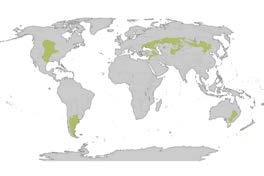
Note. Figure from Temperate grasslands, savannas and shrublands [File], by Terpsichores, 2013, Wikimedia Commons. (https://commons.wikimedia.org/wiki/File:Map_of_temperate_grasslands,_savannas_and_ shrublands_biomes.svg). CC BY-SA 3.0.
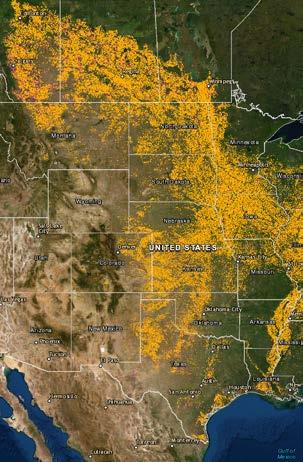
. Figure from Plowprint Report, World Wildlife Fund, 2021 (https://www.worldwildlife.org/publications/2021-plowprint-report)
Note
Figure 7
Great Plains of North America
Figure 6
Intact temperate grasslands in the world
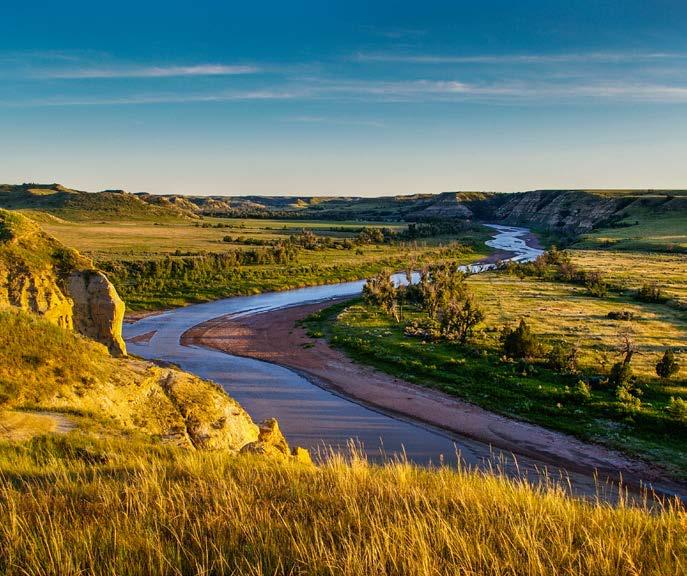
Badlands of North Dakota, part of the Great Plains.

(https://www.jimrichardsonphotography.com/index/G0000jTsL79SfOHw/ I00005p25tulJO7Q).
Note. From Soil Scientist preparing Soil Pit with Root Wash [Photograph], by Jim Richardson, xxxx, Jim Richardson Photography,
Figure 8
Roots of Native Grasses versus Roots of Wheat Crops
Design for Soils
Jim Richardson has a photography series that seeks to shine a light on the typically invisible world beneath the ground. In the photo on the left we see a Land Institute demonstration of soil health relative to perennial native grasses and wheat that is farmed seasonally. He is working to share the rich story occurring underground, which can be profoundly different than the visual evidence above ground, in which the two conditions can appear similar. Because most farmed rowcrops are grown for a single season and turned over [tilled], the root systems and their attendant ecologies and carbon storage are killed, halting carbon uptake. Further, the process of tillage appears to result in soil carbon release, but varies widely depending on a number of factors, according to the University of Nebraska’s Cropwatch. On the other hand, perennial grasses can be grazed by ruminants or go dormant in the winter while their roots remain intact.
Most people are familiar with the role of forests in the carbon cycle, but less appreciated is the impact of soils. As noted in the earlier section on the carbon cycle, plants sequester carbon during photosynthesis and store the carbon in the growth of the plant- both above ground, but in particular below ground in a system of roots and fibers. The amount of carbon released is impacted by a variety of conditions, like the moisture and heat that can increase both the growth of plants and the respiration, as well as local conditions like type of soil and other micro-climate factors. Thus the amount of carbon any given soil can sequester will vary considerably by region, and even dramatically within an area, and has a natural limit. Healthy soils are this interconnected ecosystem, far more than the “dirt” we might think of. When combined with wider
animal habitats and water retention, soil health is effectively the foundation of a rich and flourishing natural place. Soil Organic Matter is thus more of a symptom of a thriving ecosystem and should ideally be considered as part of the wider potential for landscapes to heal and improve our world.
Jason Radcliff wrote “The Big Deal with Dirt” about the challenges of maintaining and specifying healthy soils in the July/August 2022 edition of Texas Architect, focusing primarily on the processes needed in construction. There are a number of best practices related to soil health in landscape construction which should be considered, primarily around the appreciation that soils are a living organism and require more attention than simple fill. He advocates for ways to assess, improve, reduce compaction, and monitor soil health. With a new appreciation for the positive synergistic impacts on water retention, habitat formation, and greenhouse gas mitigation, soils should be a primary tool for designers interested in creating long-living, sustainable places.
The design firm Sasaki has introduced a new tool called the Carbon Conscience App. With it, designers can “assess carbon impact from the early stages of planning.” It is an important early step in integrating an appreciation for soil’s impact on the carbon cycle. Their tool is especially effective early in planning when zoning and land-uses are being considered in a project. As with any carbon calculators we would advise caution in focusing too much on specific numbers since the fidelity of data is still in its infancy and varies considerably by region and site. That said, it can be an effective means for generating better practices around soil, habitat and site uses.
Regenerative Ranching
When considering land use, habitat and carbon sequestration, regenerative ranching may present an alternative to rowcrops, maintaining land as productive and valuable to owners as part of a larger effort of prairie restoration. The premise is that a significant amount of rowcrops are perhaps not as necessary when looking at them through this holistic lens; in particular acreage used for biofuels and cattle feed might be suitable for regenerative ranching.
It is worth noting that there is considerable and passionate conversation about the morality of meat consumption, but this white paper takes the premise that humans are omnivores and will largely at this time continue to consume agricultural meat. We are considering an alternative that would improve living conditions of animals while also seeking to find alignments with habitat and carbon sequestration.
With our interest in the Texas region we will largely focus on the systems of cattle ranching. The dominant model assumes that cows are birthed and raised for sale to be finished at a different facility as weight is the primary currency of the cattle industry. Most birthing operations are grass fed with supplemental feed and water as needed. Most grass fed operations will try to limit purchased feed and water as typically it can be relatively expensive, especially in times of drought when supplies are limited. Grass fed cattle tend to graze and put on weight more slowly, while feed lots focus on quickly adding weight and taste to the meat, primarily via corn, which can grown on premises or worse, transported. From the lens of habitat and greenhouse gas emissions, it is not an exaggeration to say that the large-scale corn-fed lot operations are significantly more
detrimental. It is worth noting there is some disagreement on whether grass or corn fed lead to worse greenhouse gas outcomes, as grass-fed beef do emit more methane than corn fed, especially assuming the time frame per pound is slower for grass. There are other factors including antibiotics and the soil health topics we are focused on, however, that lead to our interest in grass fed regenerative ranching.
Regenerative ranching doesn’t have a single definition but is a growing conversation around how ruminants advance through the agricultural cycle from birth to consumption. The general concept is to use practices that support long term health of the landscape while still producing meat for consumption. High intensity rotational grazing [HIRG] is a key strategy that aligns well with native habitat health and soil carbon sequestration. The idea is that given free range, cattle will continually deplete their preferred grasses [often deep root native species] and not allow for regrowth. By condensing the heard into a smaller paddock and forcing them to eat all variety of vegetation, from native grass to invasive weeds, the other paddocks remain open for regeneration and growth. The native grasses can remain dominant over invasive species that might otherwise take a foothold. It may seem counter-intuitive but intensive grazing actually allows native grasses to thrive. The management of rotational grazing can be more intensive, but there are new technologies and services that can offset additional cost inputs.
This form of regenerative ranching has been demonstrated to be viable, but is challenged by subsidies for corn that allow feed lots to bring cheaper meat to the market. Farm Bill and agriculture politics are beyond the scope of this white paper, but have a significant impact on the potential for regenerative ranching to be more widely accepted.
High Intensity Rotational Grazing
Continuous Grazing
• Less management / cost
• Uneven pasture use
• No pasture recovery
Simple Rotational Grazing
• More management / cost
• Structured pasture use
• Short pasture recovery
Intensive Rotational Grazing
• Greater management / cost
• Intentional pasture use
• Long pasture recovery
Note. Graphic by Jennifer Chorosevic, 2024, Lake Flato Architects.
Carbon credit ecosystem



Land Owner

◦ Recreational land user
◦ “Agriculture land exemption” tax credit
◦ Receive 20% of CO2 profits

Owner / Operator May (or may not) practice regenerative ranching
◦ Manage rotational grazing
◦ Receive 80% of C02 profits

◦ Project facilitator
◦ Finds CO2 buyers (broker), manages soil testing
◦ Receive 20% of CO2 profits
◦ Independent third-party
◦ Verifies and assigns “carbon credit” per metric ton of C02 in soil


to
Note. Graphic by Jennifer Chorosevic, 2022, Lake Flato Architects.
Carbon Credits
Purchasing carbon credits are one important tool in the economics of supporting carbon sequestration in soils. They offer an incentive for a land owner to adapt practices to sequester carbon while offering the purchaser an offset for carbon emitted through their activities. For example, Lake|Flato offsets our air travel by purchasing certified carbon sequestration credits in the same amount. Often these credits can be “stacked” for greater effect, for instance with similar habitat or wildlife incentives that take advantage of the same practices that support carbon sequestration.
Since there is not centralized or government oversight, we must research the efficacy of the activities behind the credits, which can range from protecting or planting forests, supplanting fossil fuel use, or anything that can be proven to remove carbon from the cycle. Sometimes these are removing greenhouse gas from the atmosphere, and other times it is preventing further carbon output. To better understand the mechanisms of carbon credits, we interviewed Soilworks, based in San Antonio. They offer a number of services around the carbon sequestration market
At a simple level, Grassroots Carbon, a part of Soilworks, acts as a broker to arrange the certification and sale of a credit on the
market, passing a percentage back to the owner. In most cases 80% goes to the owner while 20% is retained by Soilworks. They use a third party certification and testing system like B.Carbon to ensure that carbon is being sequestered in the soil.
Since some landowners don’t manage their land, or don’t want to update practices, Soilworks, via Grazing Lands, also offers services to consult, manage or even lease land for other cattle for high intensity rotational grazing. They can be paid by a portion of the carbon credit, further reimbursed by selling grass-fed beef, in this case the brand Wholesome Meats, to interested markets like HEB.
Since the carbon market is voluntary, the price per pound is still limited below a point that would incentivize major actionable changes, as noted by Fuss et al, This means that the price per pound of grass-fed beef at the market is notably higher than an equivalent amount of corn-finished meat supported by federal subsidies. Consequently, there are fewer consumers willing to pay a premium for beef that has attendant carbon and habitat benefits. If the carbon market evolves to be mandatory, or corn subsidies are reduced, this disparity would be worth tracking to see how market behavior changes, from land-use to food sales.
Next Steps
• Employ design strategies and specifications that support soil health.
• Work with Landscape Architects and other professionals that have experience in designing for healthy soils.
• Advocate for landscapes that result in deeper, long lasting roots.
• Integrate the Carbon Conscience App when possible.
• Support carbon credits that result in healthier soils.
• When choosing to buy meat, source locally from ranches that utilize high intensity rotational grazing, or other regenerative techniques.
• Advocate for land use practices that preserve native perennial plants.
• Consider other land use solutions via Project Drawdown

Figure 11
High Meadow Residence, designed by Lake Flato Architects Note. Photograph by Shade Degges, 2023.
References
Agriculture and Food. (2021, September). Measuring and reporting soil organic carbon. Government of Western Australia, Department of Primary Industries and Regional Development. https://www.agric.wa.gov.au/soil-carbon/measuring-andreporting-soil-organic-carbon
Agriculture and Food. (2022, June). What is soil organic carbon? Government of Western Australia, Department of Primary Industries and Regional Development. https://www.agric.wa.gov.au/measuring-and-assessing-soils/ what-soil-organic-carbon
Bigelow, D.P., & Borchers, A. (2017, August). Major Uses of Land in the United States, 2012 (EIB-178). United States Department of Agriculture, Economic Research Service. https://www.ers. usda.gov/webdocs/publications/84880/eib-178.pdf?v=601.7
Blackburn, J. & Medlock, K.B. III. (2020, October). BCarbon: A New Soil Carbon Storage Standard. Rice University, Baker Institute for Public Policy. https://www.bakerinstitute.org/ research/bcarbon-new-soil-carbon-storage-standard
Fuss, S., Lamb, W.F., Callaghan, M.W., Hilaire, J., Creutzig, F., Amann, T., Beringer, T., de Oliviera Garcia, W., Hartmann, J., Khanna, T., Luderer, G., Nemet, G.F., Rogelj, J., Smith, P., Vicente Vicente, J.L., Wilcox, J., del Mar Zamora Dominguez, M., & Minx, J.C. (2018, May). Negative emissions - Part 2: Costs, potentials and side effects (Environmental Research Letters 13, 063002). IOP Publishing. https://iopscience.iop.org/ article/10.1088/1748-9326/aabf9f/pdf
McCullar, E. (2022, February 16). Texas Ranchers Get Paid to Capture Carbon . Texas Monthly. https:// www.texasmonthly.com/news-politics/grassrootscarbon-regenerative-ranching/#:~:text=A%20San%20 Antonio%E2%80%93based%20start,Baker%20Institute%20 for%20Public%20Policy.
Nationgal Agricultural Statistics Service. (2021). Land Values 2021 Summary (August 2021). United States Department of Agriculture. https://www.nass.usda.gov/Publications/Todays_ Reports/reports/land0821.pdf
Radcliff, J. (2022, July/August). The Big Deal With Dirt. Texas Architect. https://magazine.texasarchitects.org/2022/07/06/ the-big-deal-with-dirt/
Sanderman, J., Hengl, T., & Fiske, G.J. (2017, September 5). Soil carbon debt of 12,000 years of human land use. (Vol. 114, no. 36). PNAS. https://www.pnas.org/doi/epdf/10.1073/ pnas.1706103114
Zelikova, J., Amador, G., Suarez, V., Kosar, U., & Burns, E. (2021, May 1). Leading With Soil: Scaling Soil Carbon Strategies in Agriculture. Carbon180. https://carbon180.org/wp-content/ uploads/2024/01/Carbon180-LeadingWithSoil.pdf
Additional Resources
Drouillard, J.S. (2018, July). Current situation and future trends for beef production in the United States of America - A review (Vol. 31, No. 7:1007-1016). Asian-Australasian Journal of Animal Sciences. https://www.ncbi.nlm.nih.gov/pmc/articles/ PMC6039332/pdf/ajas-31-7-1007.pdf
Global Carbon Atlas. (2022). Carbon Emissions. https://globalcarbonatlas.org/emissions/carbon-emissions/
Keenor, S.G., Rodrigues, A.F., Mao, L., Latawiec, A.E., Harwood, A.R., & Reid, B.J. (2021, April 14). Capturing a soil carbon economy (Vol 8: 4). Royal Society Open Science. https:// royalsocietypublishing.org/doi/epdf/10.1098/rsos.202305
Paustian, K., Larson, E., Kent, J., Marx, E, & Swan, A. (2019). Soil C Sequestration as a Biological Negative Emission Strategy (Vol. 1:8). Frontiers in Climate. https://www.frontiersin.org/ articles/10.3389/fclim.2019.00008/full
Project Drawdown. (2023) The Drawdown Roadmap: Using Science to Guide Climate Action https://drawdown.org/drawdown-roadmap
Richardson, J. (n.d.) World Food: Soil . Jim Richardson Photography. https://www.jimrichardsonphotography.com/index/ G0000jTsL79SfOHw
Salk Institute. (n.d.) Harnessing Plants Initiative. https://www.salk.edu/harnessing-plants-initiative/
Sasaki. (2021, November 17). Introducing the Carbon Conscience App. https://www.sasaki.com/voices/introducing-the-carbonconscience-app/
Schley, I., Ruis, S., Blanco, H., & Jasa, P. (2018., February 13).
Long-term Tillage and Soil CO2 Fluxes. Institute of Agriculture and Natural Resources, University of Nebraska-Lincoln. https:// cropwatch.unl.edu/2018/long-term-tillage-and-soil-co2-fluxes
World Wildlife Fund. (2021, September 14). 2021 Plowprint Report. https://www.worldwildlife.org/publications/2021-plowprintreport
Zhu, Z., Bouchard, M., Butman, D., Hawbaker, T., Zehngpeng, L., Liu, J., Liu, S., McDonald, C., Reker, R., Sayler, K., Sleeter, B., Sohl, T., Stackpoole, S., & Wein, A. (2011). Baseline and projected future carbon storage and greenhouse-gas fluxes in the Great Plains region of the United States (Professional Paper 1787). US Department of the Interior, US Geological Survey. http://pubs. usgs.gov/pp/1787/
ACKNOWLEDGMENTS
Thank you to:
Heather Venhaus
Principal
Regenerative Environmental Design
Frates Seeglison
Executive Director
San Antonio River Foundation
Lew Moorman
General Partner
Soilworks
who shared their time and expertise in the creation and/or review of this paper.
